Barb’s
husband John decided he needed a day off today.
He had a few little modifications he wanted to make to the van, and a
few little fiddly jobs he wanted to get done, so he decided to stay at
home. Meanwhile the rest of us all
headed out to the Alice Springs Desert Park.
We had planned to see a few
things today… a visit to the Alice Springs Desert Park, in particular to catch
the bird show which we thought started at 10.30am. Then we thought we would wander around the
Olive Pink Botanical Gardens in the afternoon.
 |
| Arriving at the Alice Springs Desert Park |
 |
| Mosaic in the ground at the entrance |
 |
| Wooden seating at entrance... |
We arrived just on 10am to be told we had missed the bird show as it
actually starts at 10am and we would have a good 8 minutes’ walk to get up to
the Amphitheatre where it was being held.
Once the show starts, they lock the entrance gate so if we were late we
would not be allowed in. There was a
second showing at 3.30pm. We thought when driving out
there, it didn’t look too impressive, it was tucked away in the bush, and it
seemed to just blend into the environment.
It cost us $59 for us both to get in and we initially thought that it
was pretty expensive. Thankfully, we
were proved wrong. Since we missed the
bird show, Jeremy (one of the rangers) gave us some maps on the park.
 |
| Amazing tapestry that is hug on the wall at the entrance to the theatre |
This park also had the times for various
talks and displays printed on the backside of the map. He informed us that there was the movie ”Changing Heart” which was a 20 minute
theatrical film where desert evolution comes to life and it was showing in the
theatre and it was due to start in about 15 minutes, so we thought we would go
and see that. It was actually very good
and very informative and we were quite impressed by it. In fact, we were even more impressed when it
was over and the huge screen dropped down to reveal huge plate glass windows
that overlooked the ranges behind. It
was totally unexpected and a brilliant end to the movie.
 |
| The screen dropped to reveal the mountain range scenery that is a back drop to the park. |
Looking at
our map, we discovered that at 11am there was a talk being given on “Aboriginal
Survival in the Desert” at Awaye Flat, which was in between the Desert Rivers
part of the park, and the Sand Country.
We still had about 15 minutes until the presentation was due to start so
we wandered up through the Desert River section of the park looking at the
different plants and the birds..
 |
| The old bull frog |
 |
| Heading down to the presentation on "Aboriginal Survival in the Desert" |
 |
| The Australian Bustard |
 |
| One of the many wildflowers growing in the park. |
There was obviously a lot more to this park
that we first realized and we kind of worked out there and then that we would
quite possibly be spending the whole day here if we wanted to see a good part of
the park. We arrived just as the
presentation had begun. Jeremy, one of
the Aboriginal Rangers who was very passion about the Aboriginal culture and
customs, was giving it. This certainly
came across in his talk. He was both
informative and entertaining and I learnt a lot today about the different
plants in the desert and how they used them for their food and also for
medication.
 |
| Jeremy our Aboriginal Ranger presented a talk on "Aboriginal Survival in the Desert" |
 |
| He was very passionate about his culture and it made it very interesting for us. |
 |
| Tools and food |
 |
| Made from the bark of trees |
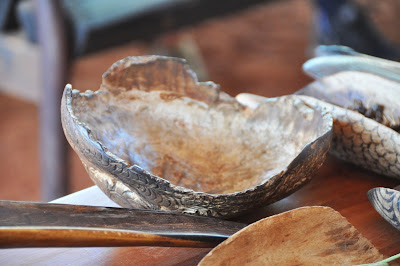 |
| made from the knobs on the gum trees |
 |
| Witchetty Grubs and fungi |
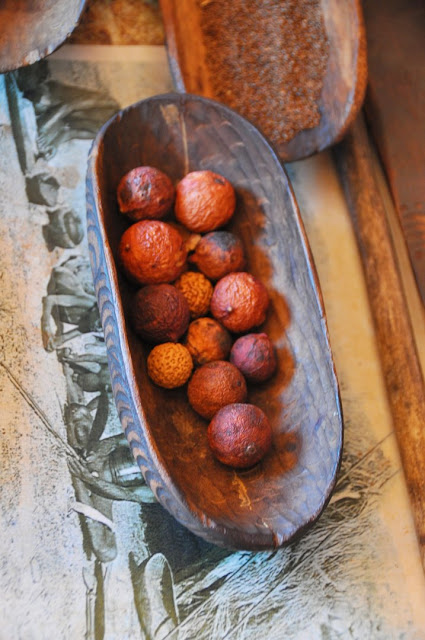 |
| different berries they chew |
 |
| Steve inspecting their bowl made the the knob out of a gum tree |
 |
| Their weapons |
 |
| Sharing it with Barb |
 |
| Learning how to throw a boomerang |
He shows us a lot of the
tools the aboriginal folk made and the different sort of woods and materials they used to make
them. I found this fascinating as some
of their bowls actually looked like turtle shells, but since there are no
turtles out in the middle of the desert, they make their bowls from the gum
tree knots. These bowls are then
engraved with symbols that represent the dreamtime stories of their areas. Finding their food is done by trial and
error, they taste and if it doesn’t kill them, it is OK. This information is then passed down from
generation to generation along with the dreamtime stories. He showed us the different grass seeds that
they use to crush and make flour for their breads, and the different berries
and saps that they use. He showed us
what to look for when looking for the witchery grubs, and how to dig down and
get them. Apparently, they taste a
little like a runny egg or scrambled egg.
I am afraid that I still don’t think I could come at eating one. They are very good for you and very high in
protein. He told many other stories
also, too many to document, but one thing for sure is, that when wandering
through the desert now, I am viewing the plants in a totally different light,
and as I look at them, I wonder what miracle cures they hold or what sort of
food they become to our indigenous peoples.
We did talk
to Jeremy for a while after his presentation and he allowed us to take some
foods with some of his artifacts.
Ian
had wandered off whilst we were still talking to Jeremy and as we finished
talking he came back to let us know that he had found the Nocturnal House, and
it was definitely worth viewing.
Apparently, it is the largest of its kind in Australia.
Before heading to the Nocturnal house we decided to back track a little and check out the bird aviary, as we had seen it on the way to the presentation by Jeremy, but we would have been late if we had stopped and gone inside. it was great. So many birds, and we were able to get some great photos of them.
On our way to the Nocturnal house we came
across some lots of flowering wildflowers and my favoutite would have been the Stuart Desert Peas…
 |
| Heading to the Nocturnal House |
Seeing the Stuart Desert Pea was one of the highlights of my day as it was one of the flowers I
wanted to see whilst in the Northern Territory.
 |
| One of the highlights of my day |
 |
| The buds of the Stuart Desert Pea |
After photographing the flowers, we continued over to the Nocturnal House. It
was really very good, it houses a huge range of animals from lizards, geckos,
snakes, spiders, bats, bilbies, rats, and insects. It was very clear to see them in their
natural surroundings and we spent quite a lot of time wandering through
there.
 |
| Thorny Devil |
 |
| Central Netted Dragon |
 |
| Cane grass dragon |
 |
| Blistered Pyrgomorph |
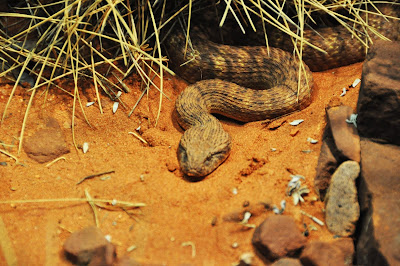 |
| Desert Death Adder |
 |
| Acacia Stick Insect |
 |
| Earless Dragon |
 |
| Pygmy Mulga Goanna |
We had a much clearer view of the
bilbies here than we did in Charleville when we were there a couple of years
ago.
 |
| Bilbies at play in the Nocturnal House |
We also got to see some of the little cave bats in their natural environment.
By the time
we got out of the nocturnal house, we were feeling a little hungry so decided
to head head back towards the café to have a bit to eat. We hadn’t packed a picnic lunch today because
we expected to be back at the caravan in time for lunch before heading out
again in the afternoon. On our way
back to the café, we stopped off to see the emu’s and dingoes.
 |
| wild dingoes |
 |
| Emus at the Desert Park |
The café was
pretty expensive, but we settled on a chicken pie along with a hot chocolate
each. It was quite cool today so
something hot when down well.
 |
| So what does everyone do whilst having lunch..... Check their phones of course |
After lunch
Steve and Ian wanted to go for a walk through the Sand Country to see what was
in there, and Kathy took off to see the birds and Kangaroos in the
Woodlands. We had planned to all meet at
2.30pm at the Meeting Point H to hear a presentations on “Incredible Edibles” –
discovering a living pharmacy in the desert.
Once again our presenter was Jeremy, and he very enthusiastically told us
about 4 different plants or animals that the Aboriginal people in this area eat
or use for medication.
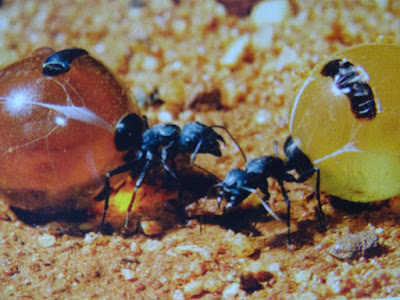 |
| Honey Ant |
The first was the
honey ant, he told us how they dig for them, how they rub them off their honey,
and how they suck it out of their bottoms without killing the ant. (that is unless they sting them real bad, and
then they squeeze them). One thing I
learnt about the aboriginal culture today is that they are very big on sharing
and caring. They only take what they
need, leaving the rest for someone else.
They do not hoard up. Even when it
comes to cash they share. They believe
that if you are greedy and take it all, than the spirits will not be happy with
you and something will happen to you sooner or later…
 |
| The bush coconuts |
The second plant he showed us was the Bush
Coconut. The tree produces a sort of
coconut as a form of resistance in protecting itself from the parasite that
lays its egg in the branch. The egg hatches into a lavre which then secretes a
substance that looks and tastes like coconut (hence the name bush coconut) The aboriginals crack the green ones open,
eat the coconut flesh, and the lavre in the centre. Once they turn black they have dies and are
no good for eating…
 |
| The witchetty grub |
The third
Incredible Edible that he showed us was the Witchetty Grub. This grubs eat and burrow into the roots of
the acacia tree. The Aboriginals know to
look for cracks in the ground under the tree and this is evidence of the witchetty
grub being in the roots. They then dig
down until they find the hollowed out root and often will find several
witchetty grubs here. The can be eaten
either raw or cooked, but you must pinch off their head before eating
them. They are high sources of protein
for the aboriginals, and actually taste like a runny egg.
 |
| Fruit from the mistletoe |
 |
| a "snottygobble" |
The last
incredible edible he showed us was the fruit on a certain kind of
mistletoe. This fruit can be eaten or
used as a sort of glue for when they make their tools. He said they actually call the fruit of this
mistletoe a “snottygobble” as it looks very much like sticky snot when squeezed
between your fingers. They don’t eat the
seed but spit it out as that part of the plant is poisonous. We did find it all very interesting.
From here it
was time to head off over to the Amphitheatre as we didn’t want to miss the
last showing of the “Free Flying Bird Show” where the free flying birds were
showcasing their natural behaviours.
Jeremy walked over with us and let us into the Amphitheatre.
 |
| Off to the Bird show |
 |
| Willy Wagtail |
 |
| It was amazing him to watch him pick up a rock to crack open the emu egg. |
 |
| The Barn Owl |
 |
| barn owl in flight |
 |
| Add caption |
 |
| Falcon |
 |
| amazing ability to fly with speed and dart and turn quickly |
This show was definitely the highlight of the
day for us. Several different birds flew
in, first the magpie, then the barn owl,
a ghost owl, hawks, falcons, and they
showed us how these birds dive, twist turn and just how smart and fast they were. It was very educational and entertaining as
well. A highlight of the day and a nice
way to end our time at the Desert Park.
I would recommend a trip out to the Desert Park to anyone. It was well worth the money.
 |
| More desert flowers at the Desert Park |
 |
| Loving the wild desert flowers out in the centre of Australia |
We left the
park around 5pm, and headed a little further down the road to check out John
Flynn’s tombstone. John Flynn was
responsible for the setting up of the “Flying Doctors Service for the Outback”
and a much respected member of the Alice Springs community including the
aboriginal folk.
 |
| At the Flynn Memorial in Alice Springs |
 |
| Visiting The "Flynn of the Inland" Memorial in Alice Springs |
 |
| Kathy and Barb at the Flynn Memorial |
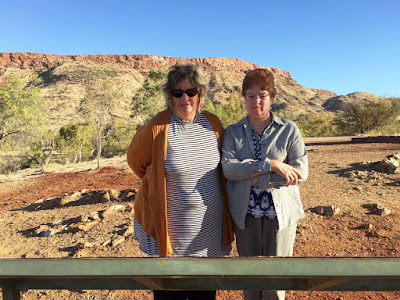 |
| Reading the information on the changing of the boulder for this memorial |
From here,
we headed back to the caravan park. We had decided that there was still heaps to
see in Alice Springs so we thought we would see if we could remain an extra
night at the caravan park and if we could, we would go and visit the Olive Pink
Botanical gardens tomorrow along with a visit to the Ghan Museum. If we couldn’t stay where we were for another
night, we would do these when we returned from the centre in a week’s time. Fortunately, we are able to have another
night at the park so we booked in and paid for it.
We were all
a little wind burnt, sun burnt and tired, when we arrived home and we were also
very thankful to John who had stayed home and offered to cook dinner for
us. What a feast he served up too. Marinated chicken with satay sauce, and
turmeric rice and vegetables. Absolutely
delicious. It was really cold tonight,
perhaps our coldest night here yet, so we didn’t linger too long outdoors. In fact, we actually even turned our heater
on tonight to go to bed.






















































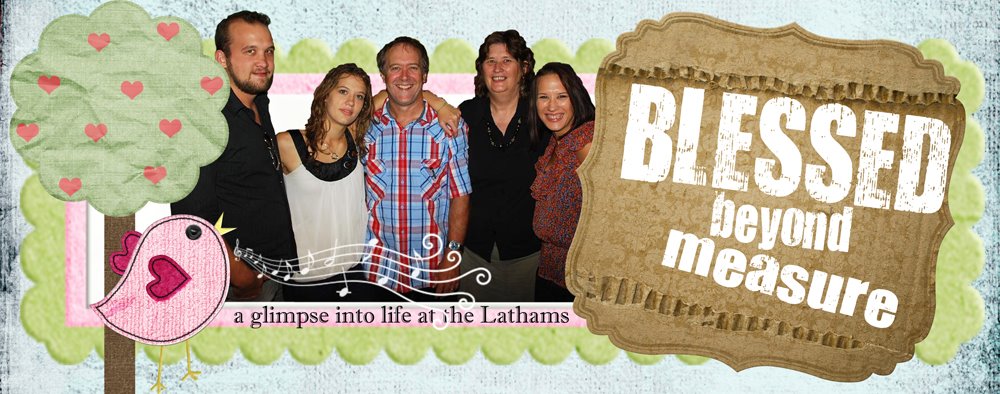










































0 comments:
Post a Comment